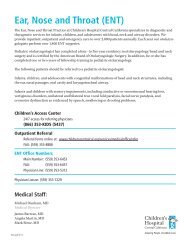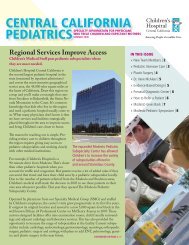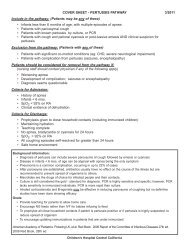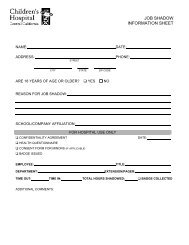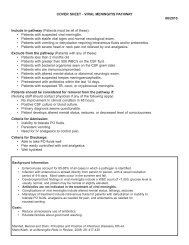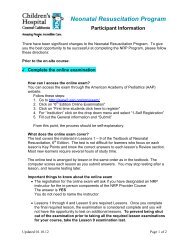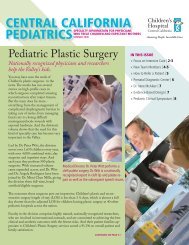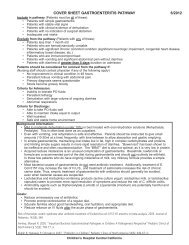Diabetic Ketoacidosis Pathway - Children's Hospital Central California
Diabetic Ketoacidosis Pathway - Children's Hospital Central California
Diabetic Ketoacidosis Pathway - Children's Hospital Central California
- No tags were found...
You also want an ePaper? Increase the reach of your titles
YUMPU automatically turns print PDFs into web optimized ePapers that Google loves.
<strong>Diabetic</strong> <strong>Ketoacidosis</strong> <strong>Pathway</strong> - Admission to Floor<strong>Diabetic</strong> <strong>Ketoacidosis</strong> (DKA) is a life-threatening condition caused by a lack of insulin. Uncomplicated DKAshould resolve in 12-24 hours. Resolution is defined as correction of acidosis. The most serious complicationof DKA in children is cerebral edema. The incidence of cerebral edema is 1:100 episodes of DKA. Cerebraledema is most likely to occur after initial fluid and insulin therapy has begun; usually 6-12 hours into the treatmentof DKA. The mortality rate is at least 20% and the risk for morbidity from permanent neurologic impairmentis even greater than this. The avoidance of cerebral edema and the correction of acidosis are the primarygoals of the treatment of DKA in children.Include in the pathway - patient is suitable for admission to the floor (Patients must be all of these to be putonto pathway):• Hyperglycemia (serum glucose > 300 mg/dl on initial laboratories)*• Acidosis (HCO 3 7.1 and rising documented by repeat blood gas after 2 hours of resuscitation• Mental status appropriate• Glasgow Coma Scale >12Exclude from the pathway - patient requires 1:1 or 1:2 nursing and should be admitted to the PICU or, ifappropriate, should be managed in the ED until an appropriate bed is available (Patients may be any ofthese):• pH < 7.1• Less than 2 years of age• K+ < 3.5 mEq/L on initial labs• K+ > 6.0 mEq/L• Serum glucose > 1,000 mg/dl on initial labs• Ketones absent• Anion gap < 12 mmol/L• Glasgow Coma Scale < 12Patients should be considered for removal from the pathway and evaluated for transfer to a higherlevel of care (PICU) if: (Nursing staff should contact physician if any of the following apply):• Any deterioration in mental status or NEW complaint of headache or any other reason to suspectcerebral edemaCriteria for <strong>Diabetic</strong> Admission (not necessarily via this pathway)• Vomiting or unable to take PO• New diagnosis of diabetes and need education• DehydrationCriteria for Discharge - all of the following must be achieved prior to discharge• HCO 3 > 15 mmol/L• Anion gap < 12 mmol/L• Tolerating PO• Ambulating• All teaching complete and documented by Diabetes Educator:- Use of blood glucose meter to test blood sugars- Ability to draw up and administer insulin- Ability to keep Diabetes Diary- Ability to demonstrate knowledge of carbohydrate counting- Ability to demonstrate knowledge of signs and symptoms of hypoglycemia and treatment of hypoglycemia,including when and how to administer glucagon• Diabetes supplies in family possession• Labs drawn (for NEWLY diagnosed patients only): ICAB, TSH, anti-TPO (ANTIMAB) antibody, anti-TTG antibody• Safe and stable home situationChildren’s <strong>Hospital</strong> <strong>Central</strong> <strong>California</strong>
Background Information:* In rare cases, blood sugar may not be elevated.** Need to exclude hyperchloremic metabolic acidosisNote: Guidelines cannot be written for all circumstances and for rigid adherence. This pathway is not asubstitute for clinical judgment.References:Dunger, DB 2004. "European Society for Pediatric Endocrinology/Lawson Wilkins Pediatric EndocrineSociety Consensus Statement on <strong>Diabetic</strong> <strong>Ketoacidosis</strong> in Children and Adolescents" Pediatrics 113(2):e133-40Sperling, Mark A. Pediatric Endocrinology, Second Edition. 2002 Elsevier Science (USA): 339-344International Society for Pediatric and Adolescent Diabetes (ISPAD) 2009 Consensus guidelines. www.ispad.org.
Physician’s Signature/ID number : ______________________________________ Date: ____/____/____ Time: _________DKApage 1 of 1Patient Label0032*0032*pathway 3/20121.0 .1 cc U IU µg MS TIW QD QID QOD MSO 4 MGSO 4DRUG SENSITIVITY: WT: kgORDERS: GENERIC EQUIVELANT WILL BE DISPENSED UNLESS ORDER SPECIFIES “DO NOT SUBSTITUTE”<strong>Diabetic</strong> <strong>Ketoacidosis</strong> (DKA) <strong>Pathway</strong>Phase I: Emergency Department ManagementInsulin and Medications: Regular insulin 1 unit/mL NS Begin infusion at 0.1 unit/kg/hour =______units per hour. Flush new IVtubing with 50 mL of insulin drip solution prior to connecting to patient and starting insulin infusion.(pharmacy to send additional syringe at initiation of therapy and at RN request for line changes) Mannitol 20% 500 mL bag 0.25 g/kg IV line with in-line filter (5 micron) PRN symptoms of cerebraledema. Give by slow IV push - see Management of Suspected Cerebral Edema; call physician beforemannitol is given. [PYXIS REMOVAL]IVF:“NS+” and “D10+” refers to IVF noted below.For Glucose > 300: Run “NS+” at 1.5 times maintenance.For Glucose 201-300 run “NS+” at 0.75 times maintenance and “D10+” at 0.75 times maintenance.For Glucose
1.0 .1 cc U IU µg MS TIW QD QID QOD MSO 4 MGSO 4DRUG SENSITIVITY: WT: kgORDERS: GENERIC EQUIVELANT WILL BE DISPENSED UNLESS ORDER SPECIFIES “DO NOT SUBSTITUTE”<strong>Diabetic</strong> <strong>Ketoacidosis</strong> (DKA) <strong>Pathway</strong>Phase II: Inpatient & Insulin DripGeneralAdmitting physician: ___________________________Attending physician: ___________________________Primary service: ¨ ______________Patient Status: x Admit ¨ ObservationAdmission Diagnosis:Condition:Code status:Isolation:DKAStable¨ Full Code or ¨ __________________________Isolation for diagnosis of __________based on isolation guideline(document number 2.3562).”This orderset is intended for the patient on DKA pathway who is ready to be admitted from the ED ortransferred from the PICU.IVF and Insulin orders from the ED need to be discontinued and new orders entered.Diet NPO except medications: NPO except for ice chips and medications while on insulin dripIVF If Then, Result: Fluid rate determined based on glucose level using 4:2:1 calculation. Goal is to maintainBLOOD GLUCOSE 200-300 mg/dl during the first 24 hours of DKA treatment.o The following fluid rates assume that the patient is no more than 10% dehydrated and hasreceived adequate fluid resuscitation prior to being placed on pathway.a. Blood glucose > 300 mg/dl: NS with 40 mEq KCl/liter at 1.5 times maintenance.b. Blood glucose 201 - 300 mg/dl: NS with 40 mEq KCl/liter at 0.75 times maintenanceplus D10 NS with 40 mEq KCl/liter at 0.75 times maintenancec. Blood glucose < 200mg/dl: D10 NS with 40 mEq KCl/liter at 1.5 times maintenance RN Communication, IVF:1. Make sure that patient has voided and that K+ is < 5.5 before hanging any potassium-containingfluid.2. If patient has not voided or if K+ > 5.5 page MD on-call for alternate fluid orders.3. Fluids and insulin should be “Y’d” together and should run through a single IVIf new IVF’s are ordered, the rate should be based upon the most recent glucose result as noted above inthe “If Then, Glu” order. D10-NS with 40 mEq KCl per liter NS with 40 mEq KCL per literDKA0032*0032*pathway 3/2012Physician’s Order Sheetpage 1 of 3Patient Label
1.0 .1 cc U IU µg MS TIW QD QID QOD MSO 4 MGSO 4DRUG SENSITIVITY: WT: kgORDERS: GENERIC EQUIVELANT WILL BE DISPENSED UNLESS ORDER SPECIFIES “DO NOT SUBSTITUTE”Basal Subcutaneous Insulin Insulin Glargine (Lantus) 0.4 units/kg subcutaneously every 24 hours. Orders received between 1700-0300 to start at ordered time. Orders received between 0301-1659 will start at 1700. (Pharmacy toedit start time)Monitoring & Vitals VS Q2H. Neuro checks Q4H If Then, VS HR: Change VS and Neuro checks to Q4h if stable for 12 hours. Monitoring: Place on bedside CR monitor while on insulin drip.MedicationsInsulin and Medications (Insulin Drip)Insulin rate should be 0.1 unit/kg/hr or whatever is currently being infused in the ED. Regular insulino Prepopulate 0.1 unit/kg/hro 1 unit/ml NS Send 2 (50 ml) syringes initially and upon RN request.o Flush new IV tubing with 50 ml of insulin drip solution prior to connecting to patient and startinginsulin infusion. Mannitol 20% 500mL bag: 0.25 g/kg IV line with in-line filter (< 5 micron) PRN symptoms of cerebraledema. Give by slow IV push - see Management of Suspected Cerebral Edema; call physician beforemannitol is given. Always keep mannitol 25% vial in or at nursing stationNursing Care Activity: No restrictions. If Then, Glu 81-100: Decrease rate of insulin drip to 0.05 unit/kg/hr and increase IV fluid rate to 2times maintenance. Page physician on-call. Recheck blood glucose in 30 minutes. If Then, Glu < 81: Decrease insulin drip to 0.05 unit/kg/hr and give a bolus of D10W 2 ml/kg IV.Increase IV fluid rate to 2 times maintenance. Page physician on-call. Re-check blood sugar in 15 minutes.If blood glucose still < 80 mg/dl give another bolus of D10W 2 ml/kg IV and recheck blood glucosein 15 minutes. Notify MD if, AMS: Page physician on-call and notify PICU attending STAT for any of the following:a. Headacheb. Deterioration in consciousness level/responsec. Unequal dilated pupilsd. Deliriume. Incontinencef. Vomitingg. Bradycardiah. Hypertension Notify MD if, UO: Notify MD for urine output > 4 ml/kg/hr or < 1 ml/kg/hr (MD may order fluid replacementof NS or NS for abnormal urinary losses). Notify MD if Lab Result: Notify MD on call immediately with results of BMP tests.DKA page 2 of 3 Patient Label0032*0032*pathway 3/2012Physician’s Order Sheet
1.0 .1 cc U IU µg MS TIW QD QID QOD MSO 4 MGSO 4DRUG SENSITIVITY: WT: kgORDERS: GENERIC EQUIVELANT WILL BE DISPENSED UNLESS ORDER SPECIFIES “DO NOT SUBSTITUTE” Notify MD if VS, HR: Notify MD if VS, BP: Notify MD if Glucose: Call MD for blood glucose < 100 or > 300 or if more than 100 mg/dl decrease inblood glucose over one hour while on insulin drip. Notify MD if Miscellaneous: Notify MD if patient is ready to transition from IV to SC insulin. Criteriainclude Bicarb > 15mmol/L, pH >7.3, anion gap > 12 mmol/L, patient wants to eat,Labs – Today Priority Source or Otherþ BMPQ4H X 48hrþ PhosphorusQ4H X 48hrþ Bedside Blood Gas Q12h X 48hr Venousþ Bedside Glucose (NUR) Q1Hþ If Then, Medication: If insulin drip is stopped then contact attending on day shift to consider stoppingthe q4h BMP, q4h Phosphorous, q12h blood gas and hourly blood glucose.Education Education: DKA per protocol. Print “Guidelines for Management of <strong>Diabetic</strong> <strong>Ketoacidosis</strong>” and give topatient. RN Communication, DC Plan: Plan on patient being discharged one day after teaching started bydiabetic nurse educator. The diabetic nurse educator will start education once the patient has beentransitioned to subcutaneous insulin (so if transition is at lunch, education should start that afternoon). RN Communication Miscellaneous: Assist patient and their family in keeping a “Diabetes Diary” atpatient’s bedside. Use only after patient is on subcutaneous insulin. RN Communication, Medication: Parent to draw up and administer all subcutaneous insulin injectionswith nursing supervision Dietary referral. Reason: DKA Social services referral. Reason: DKA. RN Communication, Miscellaneous: Please call <strong>Diabetic</strong> nurse educator to ensure they are aware ofthis patient’s educational needs. Plan to have parents available continuously once diabetic teachinghas been started by the diabetic nurse educator.Physician’s Signature/ID number : ______________________________________ Date: ____/____/____ Time: _________DKA page 3 of 3 Patient Label0032*0032*pathway 3/2012Physician’s Order Sheet
1.0 .1 cc U IU µg MS TIW QD QID QOD MSO 4 MGSO 4DRUG SENSITIVITY: WT: kgORDERS: GENERIC EQUIVELANT WILL BE DISPENSED UNLESS ORDER SPECIFIES “DO NOT SUBSTITUTE”DKA page 1 of 2 Patient Label0032*0032*pathway 3/2012Physician’s Order Sheet<strong>Diabetic</strong> <strong>Ketoacidosis</strong> (DKA) <strong>Pathway</strong>Phase III: Subcutaneous InsulinThis orderset is intended for the patient on DKA pathway who is ready to transition from insulin drip to subcutaneousinsulin. All Phase II orders should be stopped when Phase III order set is initiated.Diet RN Communication, Feedings: Make sure patient wants to eat. Start sugar-free oral fluids and orderage appropriate meal according to the carb-counting meal plan recommended by the R.D. (if RD hadnot seen patient, use the following guide: < 2 years = 2 carbs, 3-5 years = 3 carbs, 5-12 years = 4carbs, >12 years = 5 carbs. 1 carb = 15 grams of carbohydrates, so 2 carbs = 30 grams, 3 carbs = 45grams, 4 carbs = 60 grams, and 5 carbs = 75 grams. Snacks are not recommended)IVFEither continue current IVF or create new orders below if IVF’s are still necessary. Saline lock IV if tolerating PO’s. D10-NS with 40 mEq KCl per liter NS with 40 mEq KCL per literMedications Glargine insulin (Lantus®) 0.4 units/Kg. Rx to dispense Lantus® SoloStar® pen for initial dose ~ 10units or a multiple dose vial for dose < 10 units. Glargine (Lantus®) insulin cannot be mixed in thesame syringe with any other insulin. It is a long-acting insulin given once or twice daily. Aspart insulin (Novolog®) subcutaneously before meals. Dose will be determined by nurse using theInsulin Dose Calculation assessment. Round dose down to nearest 0.5 Insulin Aspart (Novolog) is arapid-acting insulin given before meals. Do not give insulin unless food tray is at the bedside RN Communication, Medication: After meal tray is at bedside, check patient's blood glucose and DCBOTH IV insulin infusion and IV fluids. Let the patient eat the meal, then give the aspart insulin(Novolog®) dose subcutaneously based on the Insulin Dose Calculation assessment.Lab Bedside Glucose check: Check finger stick blood sugars using patient’s own blood glucose meterbefore breakfast, lunch, dinner, 2100 and 0300.Nursing RN Communication, Miscellaneous: Before transitioning from IV to SC insulin, check to make sureHCO3 > 15 mmol/L or pH > 7.3; anion gap < 12 mmol/L. Notify MD if, Feeding: Page physician on-call if patient does not eat all carbohydrates on meal tray orif vomits Notify MD if, Miscellaneous: Make sure endocrinologist has been by to consult on the patient. If theyhave not yet been by please contact Endocrinology clinic to determine when that will occur. RN Communication, Miscellaneous:o The 0300 blood sugar is to detect hypoglycemia. No action is needed if blood sugar is greaterthan 80 mg/dl.
1.0 .1 cc U IU µg MS TIW QD QID QOD MSO 4 MGSO 4DRUG SENSITIVITY: WT: kgORDERS: GENERIC EQUIVELANT WILL BE DISPENSED UNLESS ORDER SPECIFIES “DO NOT SUBSTITUTE” If Then, Glu 60-80: Give 4 oz (120 ml) of juice orally and retest blood sugar in 15 minutes. Repeatuntil blood sugar is greater than 100 mg/dl. If necessary to repeat more than twice, page physician oncall. If Then, Glu < 60: If blood sugar is less than or equal to 60 mg/dl, give 8 oz (240 ml) of juice orallyand recheck blood sugar in 15 minutes. If blood sugar still less than 60 mg/dl, page MD on call. Ifblood sugar is 60-80 mg/dl, follow instructions above. Notify MD if, Glucose: Page physician with pre-meal blood sugar for insulin orders, unless ordershave already been written to cover that dose. Insulin orders should be reviewed and revised at leastonce every 24 hours. RN Communication, DC Plan: Plan on patient being discharged one day after teaching started by diabeticnurse educator. The diabetic nurse educator will start education once the patient has been transitionedto subcutaneous insulin (so if transition is at lunch, education should start that afternoon). RN Communication Miscellaneous: Assist patient and their family in keeping a “Diabetes Diary” atpatient’s bedside. Use only after patient is on subcutaneous insulin. RN Communication, Medication: Parent to draw up and administer all subcutaneous insulin injectionswith nursing supervisionPhysician’s Signature/ID number : ______________________________________ Date: ____/____/____ Time: _________DKA page 2 of 2 Patient Label0032*0032*pathway 3/2012Physician’s Order Sheet
Fluidml/hrFluidml/hrFluidml/hrInsulinunit/kg/hrUrineOutputHROutsideFacilityCHCCED07 08 09 10 11 12 13 14 15 16 17 18 TotalRRBPTempBloodGlucose mg/dl mg/dl mg/dl mg/dl mg/dl mg/dl mg/dl mg/dl mg/dl mg/dl mg/dl mg/dl mg/dl mg/dl mg/dlI.D. #NaKClCO 2BUN/CrCaPhospHGlascowComaDKA0621*0621*pathway 3/2012FlowsheetPatient LabelDate: _________________
Fluidml/hrFluidml/hrFluidml/hrInsulinunit/kg/hrUrineOutputHROutsideFacilityCHCCED19 20 21 22 23 24 01 02 03 04 05 06 TotalRRBPTempBloodGlucose mg/dl mg/dl mg/dl mg/dl mg/dl mg/dl mg/dl mg/dl mg/dl mg/dl mg/dl mg/dl mg/dl mg/dl mg/dlI.D. #NaKClCO 2BUN/CrCaPhospHGlascowComaDKA0621*0621*pathway 3/2012FlowsheetPatient LabelDate: _________________
Diabetes DiaryINSULINBLOOD SUGAR TESTSDate Brk Lunch Din Bed Brk Lunch Din Bed NT Comments1.2.3.4.5.6.7.8.9.10.11.12.13.14.15.16.17.18.19.20.21.22.23.24.25.26.27.28.29.30.31.Break A.M. Lunch P.M. Dinner Bed TimeCARBSCarb = 15 grams of Carbohydrates
Diabetes DiaryINSULINBLOOD SUGAR TESTSDate Brk Lunch Din Bed Brk Lunch Din Bed NT Comments1.2.3.4.5.6.7.8.9.10.11.12.13.14.15.16.17.18.19.20.21.22.23.24.25.26.27.28.29.30.31.Break A.M. Lunch P.M. Dinner Bed TimeCARBSCarb = 15 grams of Carbohydrates
Diabetes Education Check-ListMust be completed prior to discharge of NEW patientsInitials____ 1. Able to use blood glucose meter____ 2. Able to correctly draw up and administer insulin____ 3. Diabetes Diary filled out - parent understands how to keep____ 4. Demonstration of carbohydrate counting knowledge (and ability to recite meal plan ifappropriate)____ 5. Ability to recognize signs and symptoms of hypoglycemia and able to demonstrate how totreat - including when and how to use glucagon
GUIDELINES FOR MANAGEMENT OF DIABETIC KETOACIDOSISThe following represents a plan for the management of diabetic ketoacidosis (DKA) in children. The necessityfor individualization of therapy in DKA (or any other life-threatening illness) is acknowledged and it is recognizedthat there are many acceptable methods for treating DKA. These guidelines are not meant to be static.Each case should be assessed individually and reassessed frequently. The Diabetes attending on-call shouldbe notified for any patient admitted for DKA.Definition of DKA:Hyperglycemia (serum glucose >300 mg/dl)Acidosis (bicarbonate or equal to 1:2 dilution)AcetoacetateB-hydroxy-butyrateOther considerations:Hyperglycemia (including nonketotic hyperglycemic coma)Hyperglycemia with ketosis (glucose >300; pH >7.30; HCO 3 : >15)Note: there can be a poor correlation between acidosis and level of glycemia. Remember that DKA is a stateof insulin deficiency - whatever the cause.Mainstays of therapy:1. Fluids2. Electrolytes (Na+, K+, HCO 3 -, PO 4 2-, Ca++)3. Insulin4. Glucose5. MonitoringI. Initial Management of DKA (usually in the ED): for either a newly diagnosed diabetic or establisheddiabetic with an intercurrent problem:A. Careful history: search for any acute trigger for the DKA such as infection, trauma, or failure totake insulin.B. Physical Examination: VS, weight, extent of dehydration, level of consciousness, focus of infection.Common physical findings: Kussmaul respirations (deep, rapid respirations resulting inelimination of CO 2 ), smell of acetone on breath, dehydration, glucosuria and ketonuria, oftenassociated with changes in level of consciousness and vomiting.C. Initial Laboratory Assessment:1. All patients: glucose, electrolytes, phosphate, calcium, BUN, creatinine, U/A withmicroscopic (send to lab - obtain STAT, if possible).2. All patients: finger stick glucose level to correlate with serum value and urine dip forglucose and ketones (do at bedside). Finger stick blood glucoses should continue to beobtained every 1 hr while in the ED.3. Consider ABG or VBG if HCO 3 low (< 10), altered level of consciousness, or abnormalrespiratory pattern.4. All new diabetic patients: ICAB (islet cell antibody panel - includes GAD65, InsulinAutoantibody, and ICA512/IA-2), anti-thyroid peroxidase (TPO) antibody and TSH and anti-TTG antibody (for celiac disease).5. If considering Type 2 diabetes, obtain insulin level (if patient has not yet received insulin) ora C-peptide level and a comprehensive metabolic panel (for liver function and lipids).6. Appropriate cultures and CBC if an infection is suspected.D. Expected initial laboratory results:1. Glucose high2. Sodium lowa. Sodium/glucose ratio: with hyperglycemia, measured Na+ decreases approximately 1.6mEq/L per 100 mg/dl rise in glucose (Moran, West J Med 142:49; 1985).3. Potassium high, normal, or lowpage 1 of 5
4. Acidosis variable5. Anion Gap > 12 mmol/L ([Na+] - [HCO 3 - + Cl-]).a. Hyperchloremic metabolic acidosis can present with low bicarb and an anion gap < 12mmol/L.E. Fluids: goal is to avoid excessive fluid administration or rapid osmotic shifts. Be gentle. Donot over hydrate.1. General principles. Fluid therapy must be individualized. Good data are essential. Carefuland accurate I/O and daily weights are indispensable. Use a flow sheet to record vitalsigns, fluid, laboratory, and therapeutic data. Evaluate/reevaluate progress frequently andreadjust therapy as required.2. Patients should generally be kept NPO, especially if hyperventilating, vomiting, or havingan altered state of consciousness (ice chips may be appropriate).3. Initial fluids: begin hydration immediately, while waiting for labs. Normal saline is the bestinitial fluid for all patients. Initial therapy should be directed at treating hypovolemia IFPRESENT. In order to restore appropriate intravascular volume, give 10-20 ml/kg ofnormal saline as a rapid infusion. If necessary, can give additional 10 ml/kg every houruntil intravascular volume is restored.4. Initial rehydration can cause a significant drop in serum glucose. Need for hourly glucosemonitoring.F. Insulin: Remember that DKA is a state of insulin deficiency. Insulin therapy in DKA is aimed attreating not only hyperglycemia, but also ketosis and acidosis.1. A continuous IV infusion of regular insulin should be used in moderate-severe DKA.2. Begin piggyback solution of regular insulin 0.05-0.1 unit/kg/hr: CHCC standard insulininfusion solution is 1 unit/ml in normal saline. Insulin drip should be initiated at 0.05 /kg/hr if:a. Patient has serum blood sugar >1,000 mg/dl.b. Patient < 2 years old.c. DKA is less severe or serum glucose is < 500 mg/dl.3. The infusion rate should be increased if blood glucose does not fall at least 50 mg/dl perhour, or the bicarbonate does not rise at least 0.5 mEq/L per hour.4. The infusion rate may be adjusted up or down, but should not be discontinued until you areready to switch to subcutaneous therapy.5. Rate of fall in glucose should be 100 mg/dl per hour after initial drop associated withrehydration. There can, however, be significant interpatient variability (up to 400-500 mg/dlper hour drop). Therefore, monitor glucose frequently and adjust rate as needed.6. Practical aspects of insulin infusion therapy:a. Insulin loss on polyvinylchloride and glass can be significant. Never use aconcentration less than 0.1 unit/ml. Flush new IV tubing with 50 ml of insulin dripsolution prior to connecting to patient and starting insulin infusion.b. Make up fresh insulin solution at least every 24 hours.c. Because of adsorption, the actual amount of insulin being administered could besubstantially less than the apparent (labeled) amount. Adjustment of the insulininfusion rate should be based on effect and not solely on the apparent insulin dose.II. Ongoing ManagementA. Monitoring:1. Cardiac monitor should be used until metabolic status has normalized.2. It is often necessary to treat moderate-severe DKA in the PICU because of the need forfrequent blood draws, close monitoring of mental status, and 1:1 nursing (at least until thepH is > 7.25 and the serum bicarbonate is rising).3. A heparin lock is a humane method for obtaining repeat blood samples.page 2 of 5
B. Fluids:1. Components:a. Emergency rehydration (usually done in ED)b. Established deficitc. Maintenanced. ABNORMAL ongoing losses2. Determining fluid requirements:a. Establish deficit - dehydration is commonly in the range of 5% (rarely more than 10%)and is frequently overestimated. Body weight before onset of DKA can help withcalculation of deficit. Cap refill > 3 sec also helpful in establishing significant deficits.Urine output and urine specific gravity, in the face of heavy glucosuria and ketonuria,are not helpful.b. Determine maintenance - based upon body weight (usual methods - see below ifunsure). Adjust, if necessary, for fever or hyperventilation.Definition of maintenance fluids:1-10 kg 4ml/kg/hr11-20 kg 40 ml/hr + (2ml/kg/hr for each kg >10)>20 kg 60 ml/hr + (1ml/kg/hr for each kg>20).c. Calculate fluid requirement and replace evenly over 48 hours:[(Deficit - Emergency rehydration ) +Maintenance] = ml/hr48 hoursd. Replace ABNORMAL ongoing urinary losses in excess of 70% of maintenance(remember that 60% of maintenance fluids normally allocated to urine production) orother unexpected fluid losses (vomiting). Accurate I/0 only way to determine this.e. NS is generally appropriate after the initial phase of rehydration.f. Note: once patient is taking PO and is on subcutaneous insulin, they correct residualdeficits on their own.3. Glucose:a. Conventionally, glucose (D5 or D10) is added to IV fluids when blood glucose has fallento 250-300 range. Glucose may be added sooner to avoid rapid falls in serum glucoseonce initial rehydration is completed and insulin is infusing. There should be a bag ofNS and D10 NS at the bedside ready to be hung. Can "Y" together the two fluidsto achieve desired dextrose concentration.b. Keep serum glucose over 200 mg/dl in the first 24 hours of therapy to avoid rapidosmotic shifts, which may contribute to development of cerebral edema, which isfrequently fatal in this setting.c. In general, 2 to 4 grams of glucose per unit of insulin (IV) will maintain stable bloodglucose.4. Potassium:a. Even if initial K+ levels are elevated, DKA is a state of total body potassiumdepletion. As acidosis improves, intracellular H+ is exchanged for extracellular K+,decreasing serum K+. Insulin drives K+ into cells; contributing to decreases in theserum K+. Potassium requirements are generally 1-5 mEq/kg in first 24 hours of therapy.b. Start K+ therapy as soon as possible: when serum K+ is
is adequate, although there are theoretical reasons for using KPO 4 or KAcetate. Rateof administration should generally be < 0.5 mEq/kg per hour.d. If using phosphate, monitor Ca++ levels, as there is a risk of hypocalcemia.e. Monitor K every 1-2 hours. Avoid both hypo- and hyperkalemia (either can be fatal).C. Insulin:1. Follow serum glucose hourly while on continuous insulin infusion. Adjust rate to keepserum glucose greater than 200 mg/dl for first 24 hours of therapy to decrease risk ofcerebral edema.2. It is generally better to increase dextrose concentration rather than to decrease insulininfusion if blood sugar is falling too rapidly (although both may be necessary). Insulin is GOOD!D. Laboratory:1. ABG or VBG hourly if initial arterial pH is < 7.15 until pH > 7.20-7.25 and rising without useof bicarbonate. (VBG generally ok since O 2 problems are rare).2. Follow electrolytes every 2-4 hours initially (depending upon severity of ketoacidosis), orhourly if:a. Initial K < 5 or > 6.5 mEq/Lb. Not giving parenteral Kc. Giving > 40 mEq/L or > 0.5 mEq/kg/hr of KCld. Giving bicarbonatee. Significant hyperosmolarityf. **Na+ or HCO 3 not rising appropriately3. Glucose levels using bedside glucose meter initially hourly and every 1 to 2 hours until stable;one hour after any change in the insulin infusion rate.4. Serum calcium if giving bicarbonate or phosphate.5. Use a flowsheet to follow monitoring.**Na+ should always be rising. It is the best indicator of osmolality. A falling Na+ is a serious indication ofoverhydration and adjustments in fluid management must be made immediately.Calculated Serum Osmolality:[(Na+ + K+) x 2] + glucose + BUN18 2.8Na+ is the big actor!III. Conversion from continuous insulin infusion to subcutaneous insulin: Most cases of DKA are significantlyimproved within 24 hours. Because of adsorption of insulin to the infusion container and tubing, theapparent (labeled) dose should not be used solely as the basis for determining the subsequent insulindose upon discontinuing the insulin infusion. Appropriate post-infusion insulin dosing requires closemedical supervision.IV.A. Glucose is in 200-250 range, HCO 3 is > 17 (or pH > 7.3), anion gap < 12, urine ketones arelargely cleared (ketones may persist even after acidosis is cleared), and patient has been startedon PO clears and is taking them without difficulty.B. Make sure patient wants to eat and order a diabetic carb counting diet as recommended by R.D.based upon patients' home meal regimen.C. Calculate starting dose (new patients): most patients who have had DKA will need 1 unit/kg/day(total daily dose, TDD) subcutaneous insulin. Determine the dose as follows:60% of TDD given as insulin Aspart (Novolog) insulin with breakfast, lunch and dinner(20% with each meal)AND40% of TDD given as Glargine (Lantus) once a day, breakfast, lunch or dinner,whichever meal the transition occurs at. (Some patients may require BID dosing perendocrine) Move the Glargine (Lantus) ahead a few hours daily until Glargine (Lantus) isgiven at dinner or bedtime.page 4 of 5
*Glargine (Lantus) insulin CANNOT BE MIXED with any other type of insulin; therefore,two separate shots must be given at dinner.D. A patient with established diabetes should usually return to their home insulin regimen once DKAhas resolved.E. Once food is at the bedside and patient wants to eat, give subcutaneous insulin and then turn offboth IV insulin and IV fluids. Make sure patient eats.F. Change blood sugar checks to before each meal, at 2100, and at 0300.G. Adjust dose daily based upon the previous day's blood sugars. Do not write standing orders forsubcutaneous insulin on a new patient.H. Use subcutaneous insulin technique as follows:1. Use ultrafine II short needle syringes2. Choose injection site; use a good site rotation plan3. Make sure the site is clean4. Gently pinch up the skin and fat tissue5. Inject straight in, at a 90 degree angle, pushing the needle all the way into the skin. If theneedle is not in far enough, the insulin may not be injected into the fatty layer. If it goesinto the layer directly under the skin rather than into the fatty layer, it will sting and maycause a bump or redness and itching6. Release the pinch before injecting the insulin, or you will be squeezing the insulin out atthe same time you are trying to inject it7. Push the insulin in SLOWLY and steadily8. After the insulin is in, wait five to ten seconds before removing the needle. COUNT TOFIVE SLOWLY to prevent insulin from leaking from injection site.I. Once patient is on subcutaneous insulin, IVs should be discontinued.V. Starting insulin in a new patient who is not acidotic and has not had DKA. These patients are lessglucose toxic and generally require less insulin.A. Start with 0.5 unit/kg/day for patients age 5 and under. Add 0.1 unit/kg/day for each year of ageup to a maximum of 1 unit/kg/day (i.e. 0.6 unit/kg/day for a 6 year old, 0.7 unit/kg/day for a 7 yearold, etc.).B. Again, adjust dose daily based upon previous days blood sugars. Do not write standing insulinorders on new patients.VI. Bicarbonate TherapyA. When to use bicarbonate in DKA remains controversial. Randomized studies in adults haveshown no benefit when the pH is > 7. Studies involving children have actually shown longerhospital stays associated with bicarbonate therapy and increased risk for cerebral edema(Glaser, N. et al., Risk Factors for Cerebral Edema in Children with <strong>Diabetic</strong> <strong>Ketoacidosis</strong>. NEJM,2001;344(4):264-269.VII. Cerebral Edema - A MEDICAL EMERGENCY - usually occurs about six to 12 hours after initiationof therapy.A. Neurological checks should be done every 1-2 hours during correction of DKA.B. Mild cerebral edema (CE) occurs often in DKA. Clinically evident CE (brain swelling) occurs in1-3% of cases and mortality is about 70%. The causes are not well understood, although osmoticshifts are felt to play a role (overhydration or too sudden a fall in glucose).C. More common in patients under the age of 5 years. Occurs in both first and subsequent DKAepisodesD. Signs of CE include sudden headache, altered mental status, increasing lethargy, changes in vitalsigns (increased blood pressure, decreased heart rate) or any sudden worsening of neurologicalstatus in a patient whose metabolic status is improving (often 6-12 hours after onset of treatment).Risk is decreased after 24 hours.E. If CE is suspected, give MANNITOL 20% 500 mL bag STAT (0.25 g/kg IV push). Then reassessfluid status, ventilatory status (ABG).F. Contact Diabetes attending and PICU attending STAT.G. Head MRI or CT is often abnormal during DKA even without clinically apparent CE.H. Mannitol 20% 500 mL bag should be kept at the bedside or should be available at the nursingstation for all patients with DKA.page 5 of 5
Dictation: 1-800-411-1001 (#963)D/S Job #: ________Discharge SheetFor <strong>Hospital</strong> Use OnlyDischarge sheet FAXed to PCP _______________initial/dateFollow-up appointment SCHEDULED with PCP _______________initial/datePatient’s Name: _________________________________Discharge Date: _______________Dx: 1) <strong>Diabetic</strong> <strong>Ketoacidosis</strong> 2) _______________________________<strong>Hospital</strong> Course________________________________________________________________________________________________________________________________________________________________Complications during hospitalization: _________________________________________________________________________________________________________________________________Discharge Condition: ________________________________Discharge Weight: _________Instruction to PatientActivity: ________________________________________________________________________________________________________________________________________________Diet: Carb-counting dietMedications:See Medication Reconciliation FormAdditional instructions:Reference: Patient Education SheetSigned: ________________________________ M.D.______________________________________Attending Physician______________________________________Primary Care Physician___________________________________Signature of Parent or Guardian___________________________________Attending Resident___________________________________CityDKAPatient Label0083*0083*pathway 3/2012Discharge Instructions



